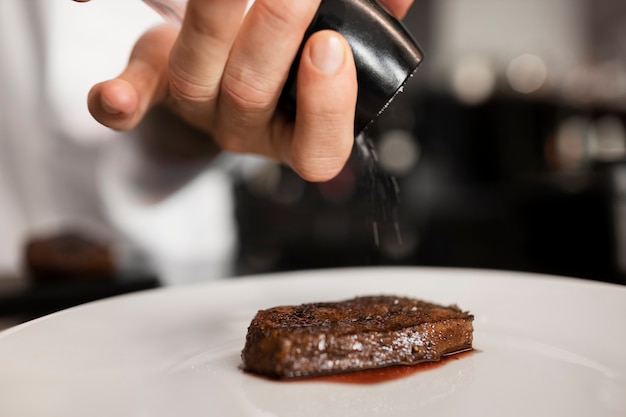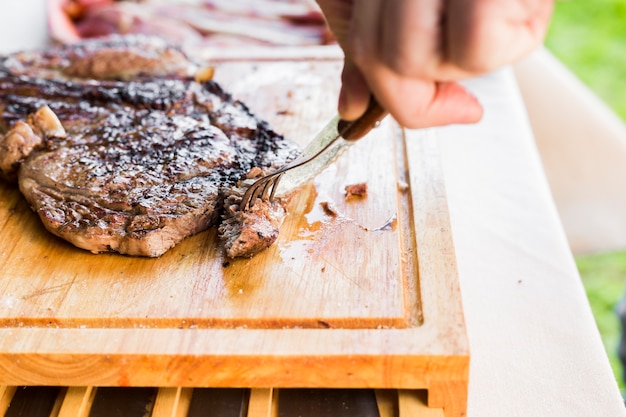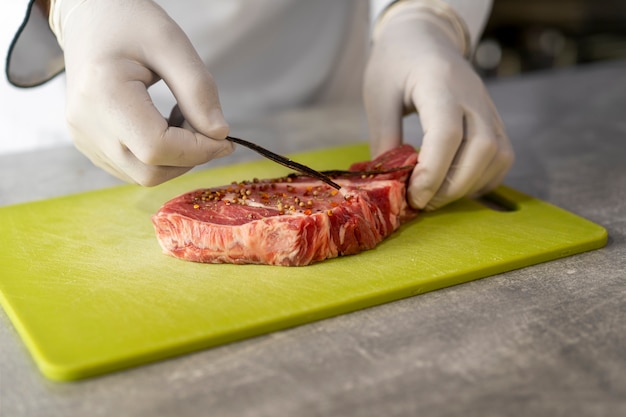Let’s talk about flat iron steak – you know, that cut of meat that's been quietly gaining popularity? It's a bit of a hidden gem, and I’m here to tell you why you need to give it a shot. Now, I'm not just some random bloke spouting off about steak. I've been cooking for years, and I've learned a thing or two about making a good meal. But let me tell you, once you've mastered the art of cooking a flat iron steak, you'll be the envy of your mates. We're talking melt-in-your-mouth tender, juicy, and full of flavour – a real crowd-pleaser.
So, grab your apron and let's dive into the world of flat iron steak. This is your ultimate guide to cooking it like a pro, filled with tips, tricks, and personal anecdotes – straight from yours truly.
(Part 1) What is Flat Iron Steak?

Alright, let's start with the basics. Flat iron steak comes from the shoulder blade, also known as the "chuck" in butcher speak. Now, this cut used to be considered a bit of an afterthought. It's a workhorse, being lean and full of flavour, but it could be a bit tough. But thankfully, times have changed. Thanks to clever butchers and modern techniques, the flat iron has become a star player in the world of beef.
Why is it Called Flat Iron?
You might be wondering, why "flat iron?" Well, it gets its name from its shape. It’s a thin, rectangular piece of meat, resembling the shape of an old-fashioned flat iron – you know, the ones your gran used to use to iron clothes?
Where Does it Come From?
Imagine a cow's shoulder blade. Now, imagine a muscle running along the top of that blade – that's where the flat iron comes from. This muscle isn't used for movement like the leg or back muscles, so it's actually quite tender, but it's also got a lot of flavour.
(Part 2) The Flavour and Texture

The beauty of flat iron steak lies in its versatility. It's lean, meaning it doesn't have a lot of marbling, but that doesn't mean it's dry. In fact, its leanness gives it a beautiful, clean flavour that's not overpowered by fat. It's like a blank canvas for your culinary creations. You can season it with your favourite spices, grill it with a smoky char, or pan-fry it with herbs and garlic. The possibilities are endless.
Is it Tender?
Now, you might be thinking, "But isn't it tough?" Well, the flat iron used to be notorious for its chewiness. But thanks to those clever butchers, that’s a thing of the past. They know how to cut this muscle correctly, removing the tough membrane – it’s a game-changer! Now, it’s actually quite tender, slicing through it with ease.
What does it Taste Like?
The flavour? It's got a nice, rich beefy flavour that’s not too strong or gamey. It’s a flavour that screams “steak” without being overpowering. This makes it perfect for all sorts of cooking styles. You can go for a simple salt and pepper seasoning, or you can get fancy with a marinade or rub.
(Part 3) Where to Buy Flat Iron Steak

Alright, now you’re probably thinking, “Where can I find this magical cut of meat?” Well, you’re in luck because flat iron steak is becoming increasingly popular. You should find it at most good butchers or supermarkets.
choosing the right cut
When you’re at the counter, make sure you choose a piece of meat that has a good colour. You want it to be a rich, deep red with good marbling. If it's got a greyish hue or looks dry, then it's probably not fresh. And trust me, you don't want to end up with a tough, dry steak.
Ask for it!
If you can’t find it, just ask your butcher! Tell them you’re looking for a flat iron, and they’ll likely be able to help you. Just don’t go saying “chuck steak” – you’ll get blank stares, and they might even think you’re from another planet.
(Part 4) Preparing the Flat Iron Steak
Before you start cooking, it’s important to give your flat iron steak some TLC. I’m talking about proper preparation – maximizing the flavour and tenderness. And believe me, a little bit of effort goes a long way.
Removing the Silver Skin
Now, remember I mentioned a tough membrane? It's called the silver skin, and it's the bane of flat iron steaks. You’ve got to get rid of this tough stuff before cooking. It’s easy, don’t worry. Just use a sharp knife to carefully slice it off. You can either peel it off, or you can cut it into small strips and then remove them.
Patting it Dry
Once the silver skin is gone, use paper towels to pat your steak dry. This will help to create a nice crispy sear on the outside. And who doesn’t love a good crust? It’s all about that texture, my friend.
Letting it Rest
Now, this is crucial. Before you even think about the heat, let your steak rest at room temperature for 30 to 45 minutes. This will allow the internal temperature to come up to room temperature, ensuring that the steak cooks evenly. Plus, it’s a good time to grab a beer and relax, right? It’s all about enjoying the process, not just the end result.
(Part 5) Cooking Methods for Flat Iron Steak
So, now we’re getting to the good stuff. How to actually cook that flat iron steak. You have a few options here, and I’ll guide you through them all. Each method has its own unique advantages, so it’s really down to personal preference.
1. Grilling
Alright, let's start with the classic. Grilling. It's the king of summer cooking, and it's perfect for bringing out the smoky flavour in a flat iron steak. You want to make sure your grill is nice and hot, with those lovely charring marks.
I always aim for medium-high heat. And you know, I’m not afraid to use a little bit of wood chips soaked in water to give it that extra smokiness. The aroma is amazing. It's a total sensory experience.
Season with salt and pepper, or get creative with your favourite rub.
And always remember, it’s not just about the heat. It’s about control. Keep turning that steak every minute or so to achieve that perfect golden-brown crust on all sides. I’m talking about even cooking, without any burnt bits.
2. Pan-frying
If you don’t have a grill, or it's a bit chilly outside, don’t worry. You can achieve that same delicious char in a pan. Now, I’m talking about a cast iron pan, preferably. It’s the best for searing, retaining heat, and giving that crispy exterior.
Heat that pan up until it’s smoking hot. Then, add a little bit of oil, and you're good to go. Don't crowd the pan. You want your steak to have space to breathe and cook evenly.
Sear for about 2 to 3 minutes per side. I like to get a good crust on each side before moving on to the next.
You can finish the cooking in the oven, or you can let the pan cool down a bit and just finish it off on the stovetop. Just be careful. It’s all about knowing your pan and the temperature.
3. Baking
Don’t think you can only cook it on the grill or in a pan. You can bake it too! This method is a bit more hands-off, and it’s perfect for those who prefer a more consistent and even cook.
Preheat your oven to 400 degrees Fahrenheit.
Season your steak with salt and pepper or your favourite rub.
Place your steak on a baking sheet and bake for 10 to 12 minutes per side.
You can add some herbs or garlic to the baking sheet for extra flavour.
Once it’s done, let it rest for a few minutes before slicing and serving.
(Part 6) Internal Temperature
Now, you’re probably thinking, how do I know when my steak is done? Well, you’ve got to understand the concept of internal temperature. This is the most reliable way to determine if your steak is cooked to your liking.
Using a meat thermometer
I highly recommend investing in a meat thermometer. It’s a lifesaver, especially if you’re not confident with judging the doneness by eye. Insert the thermometer into the thickest part of the steak, making sure it doesn't touch the bone.
Temperature Chart
| Doneness | Internal Temperature (°F) |
|---|---|
| Rare | 125-130 |
| Medium-Rare | 130-135 |
| Medium | 135-140 |
| Medium-Well | 140-145 |
| Well-Done | 145 |
How to Judge Doneness
If you're not using a thermometer, here's a quick guide to judge doneness by touch:
- Rare: The steak will feel soft and squishy.
- Medium-Rare: The steak will feel slightly firmer, but still springy.
- Medium: The steak will be firmer, with a slight give when pressed.
- Medium-Well: The steak will be firm and solid.
- Well-Done: The steak will be very firm and almost hard.
Remember, this is just a guide. Your personal preference will determine the best level of doneness for you.
(Part 7) Resting and Slicing
Now, you’ve got your beautifully cooked flat iron steak. Don’t dive in just yet! Let it rest for at least 5 minutes before slicing. This allows the juices to redistribute throughout the steak, resulting in a more tender and flavorful experience.
When you’re ready to slice, cut the steak against the grain. This means slicing across the direction of the muscle fibers, making the steak easier to chew.
(Part 8) Serving and Enjoying Your Flat Iron Steak
You’ve done it! You’ve cooked the perfect flat iron steak. Now it’s time to enjoy the fruits of your labour.
side dishes
Serve your steak with your favourite sides. Some classic pairings include:
- Roasted vegetables (potatoes, asparagus, carrots)
- mashed potatoes
- green beans
- Salad
- Macaroni and cheese
- Creamed spinach
- Roasted garlic
- Asparagus with hollandaise sauce
Sauces
Don’t forget about the sauces! A drizzle of your favourite sauce can really elevate the flavour of your steak.
- Mushroom sauce
- Béarnaise sauce
- Peppercorn sauce
- Garlic butter
- Red wine sauce
- Horseradish sauce
- chimichurri sauce
(Part 9) FAQs
1. Can I marinate flat iron steak?
Absolutely! A marinade can add even more flavour to your steak. I recommend using a marinade with acidic ingredients like lemon juice or vinegar to help tenderize the meat. You can marinate the steak for as little as 30 minutes or as long as overnight.
2. How much flat iron steak should I buy per person?
I recommend buying about 8 ounces of flat iron steak per person. It's a lean cut, so you might want to consider adding a side dish to make it a more substantial meal.
3. What is the best way to store flat iron steak?
The best way to store flat iron steak is in the refrigerator. Wrap it tightly in plastic wrap or place it in a sealed container. It should keep for 3-5 days.
4. Can I freeze flat iron steak?
Yes, you can freeze flat iron steak. Wrap it tightly in plastic wrap or freezer paper and place it in a freezer-safe bag. It should keep for 3-4 months. Remember to thaw it in the refrigerator overnight before cooking.
5. Is flat iron steak good for grilling?
Definitely! Flat iron steak is a great choice for grilling because it cooks quickly and evenly. Just be sure to grill it over medium-high heat and turn it every minute or so to achieve a nice sear.
6. Can I use a cheaper cut of steak for this recipe?
While flat iron steak is a great choice, you can definitely use other cuts of beef like skirt steak, flank steak, or even a ribeye. Just remember that these cuts might need slightly different cooking times and techniques.
7. What are some tips for making a great steak sauce?
For a simple and delicious steak sauce, you can combine a few tablespoons of butter with minced garlic, chopped shallots, and fresh herbs like thyme or rosemary. Cook the mixture over low heat until the butter is melted and the flavours have infused. You can add a splash of red wine or a bit of Worcestershire sauce for extra depth.
Everyone is watching

How to Cook Frozen Lobster Tails Perfectly: A Step-by-Step Guide
RecipesLobster. Just the word conjures up images of lavish meals, special occasions, and a taste of luxury. But let's...

Pigs in a Blanket Cooking Time: How Long to Bake for Perfect Results
RecipesAh, pigs in a blanket. Just the name conjures up images of those delightful little parcels of crispy pastry en...

Pork Fillet Cooking Time: How Long to Cook It Perfectly
RecipesPork fillet, or tenderloin as it's sometimes called, is a real favourite in our house. It's so versatile, and...

The Ultimate Guide to Cooking Delicious Frankfurters
RecipesLet's face it, we all love a good frankfurter. It's a classic, simple, and always satisfying. But let's be rea...

Wolf Meat Recipes: A Guide to Cooking Wild Game
RecipesLet's be honest, you don't see wolf meat at your local butcher shop every day. It's a bit of a wild card, but ...
